Sandstone is a consolidated sand. It is a very widespread and well-known sedimentary rock. It should be no surprise because sandstones make up 10…20% of all sedimentary rocks and sedimentary rocks are by far the most common rocks at the surface (see more interesting numbers pertaining to sand in a post brain games with sand grains).
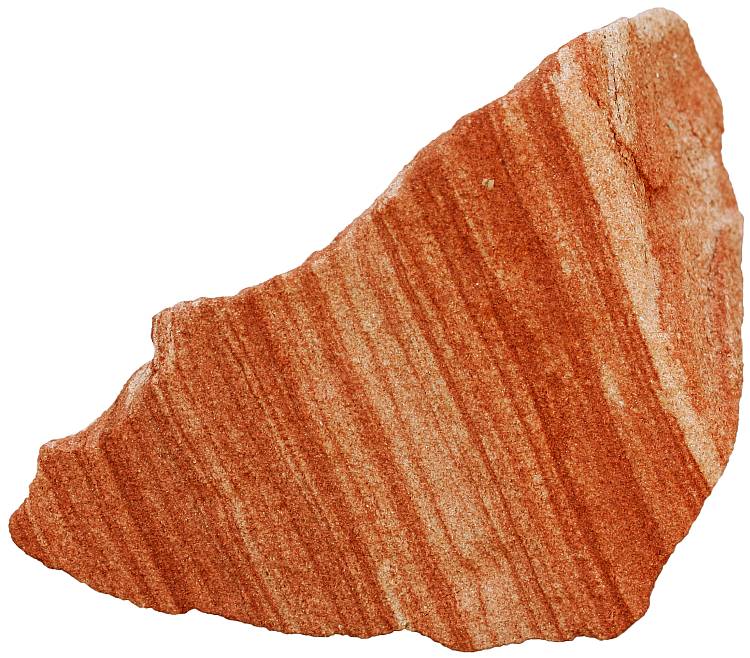
Sandstone is very often visibly layered. The width of the sample from Scotland is 7 cm.
Sandstone is composed of sand-sized (0.0625…2 mm) mineral grains, rock fragments, or pieces of fossils which are held together by a mineral cement. It grades into siltstone, shale or mudstone (grains less than 0.0625 mm in diameter) and conglomerate (or breccia if the clasts are angular) if the average grain-size exceeds 2 mm1.
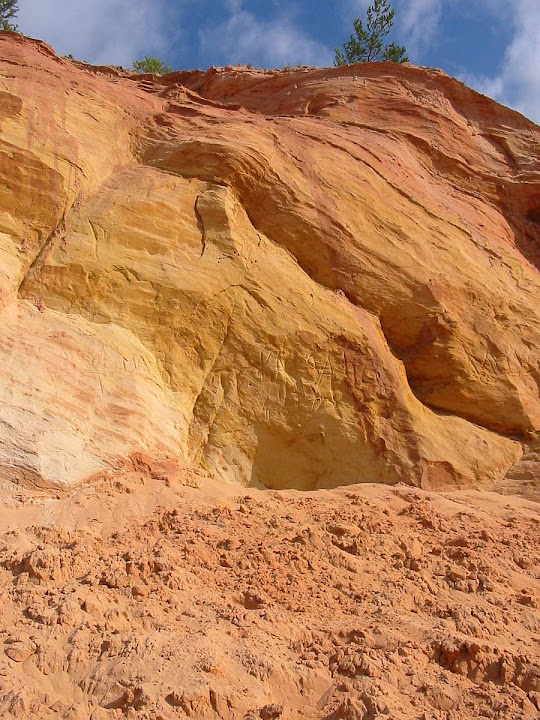
Weakly cemented outcrop from the Devonian in Estonia.

This is a clastic sedimentary rock from a turbidite sequence in Spain, but the framework grains are less than 1/16 mm in diameter which means that it is siltstone. Siltstone grains are so small that human eye can not distinguish one grain from another. The width of the sample is 12 cm.
Sandstone and other clastic sedimentary rocks differ from the igneous rocks in possessing a framework of grains which only touch each other but are not in a continuous contact. Consequently, sandstone contains a network of pores which are at least partly filled with a mineral cement. However, sandstone does not need to contain open pores, they may be, and often are, completely filled with a cementing material. The definition of sandstone is based on the size of the framework grains. No reference is made to the genesis.
Whether composition has any significanse is a tougher question to answer. It is generally not important whether it is composed of mineral grains or lithic fragments and what is the origin and proportion of these particles. Sandstone may even contain biogenic grains (shells, coralline algae, etc), but a rock that contains more than 50% of sand-sized carbonate grains is usually named calcarenite which is a type of limestone.

This coarse-grained rock from Cyprus shares both sand- and limestone properties. It is clearly clastic, but it is composed of carbonate grains of biogenic origin. Such rocks are known as calcarenite, they are considered to be a subtype of limestone. The width of the sample is 7 cm.
Naming of varieties
Sandstones are widespread and compositionally variable rocks which gives rise to a myriad of more narrowly defined varieties:
| Sandstone or related rock type | Description |
| Arenite | A general term for all sandstones. |
| Arkose | A feldspar-rich (>25%) variety. |
| Calcarenite | A limestone variety composed of sand-sized non-terrestrial carbonate grains. Sandstone which is composed of terrestrial limestone fragments is calclithite. |
| Calclithite | A variety of terrigenous sandstone consisting of carbonate grains (>50%) from disintegrated limestones. |
| Flagstone | A sandstone that is readily split into thin flags suitable for paving. Fissility is given to the rock by mica. |
| Graywacke | A term that has been defined in several ways which has caused confusion and ultimately lead to its use only as a field term. Graywacke is generally imagined to be dark-colored, coarse-grained, lithic, well-indurated, and immature sandstone. |
| Greensand | A sandstone or sand that contains lots of green clay mineral glauconite. |
| Grit | A coarse-grained variety with angular grains. The term has also been applied to fine-grained gritty rocks in the past. |
| Orthoquartzite | A relatively pure light-colored quartz-sandstone. The term has been applied to well-indurated (quartzitic) rocks in the past, but nowadays it seems to involve all pure sandstones regardless of how friable they are. |
| Psammite | A synonym of sandstone and arenite. |
| Quartz arenite | An almost pure sandstone. Quartz content is above 90-95%. |
| Quartzite | A metamorphosed sandstone. The term has been applied to hard sedimentary sandstones. |
Composition
Sandstones are composed of mineral grains or rock fragments that were once part of another rock. Therefore, it seems logical to assume that all rock-forming minerals have a chance to become sandstone constituents. Theoretically it is true, but in reality minerals differ greatly in their ability to resist weathering.
Many rock-forming minerals are simply dissolved during the transport as sand grains. Pyroxenes and amphiboles are very abundant minerals in certain dark-colored igneous and metamorphic rocks but they are relatively rare in sandstone. Feldspars are even more widespread and also more resistant to weathering. Hence, feldspars are quite common in sandstone although significantly reduced in quantity. Variety that contains more than 25% feldspar is named arkose. Quartz, on the other hand, is a common rock-forming mineral (although not as widespread as feldspars) and it is almost insoluble in water and physically very hard. This is why quartz is so abundant in sand. Some sandstones (quartz arenite) are almost exclusively composed of quartz grains. Micas are common minerals in rocks and form a significant part of certain micaceous sandstones.

An arkose sample (contains more than 25% feldspar) from Estonia. Width of sample 15 cm.
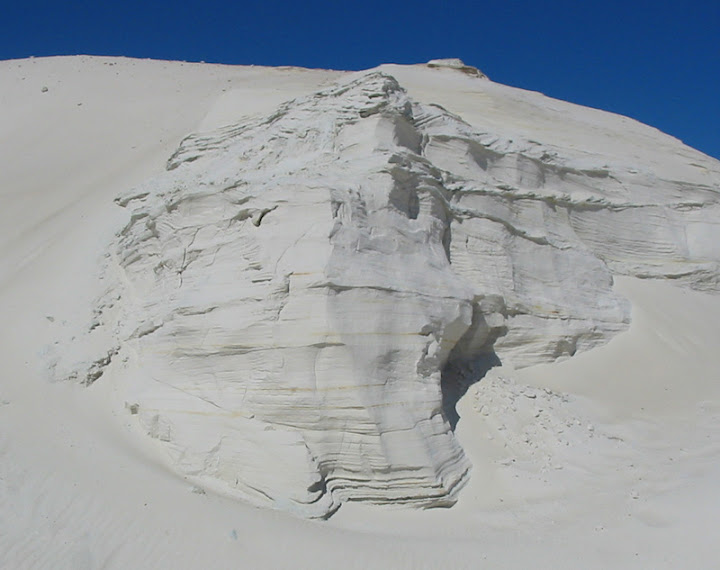
An outcrop of quartz arenite in Estonia consisting of almost pure quartz.

Poorly sorted micaceous sandstone (very rich in muscovite mica flakes) which glitters beautifully in sunshine. The sample is from Ireland. The width of the sample is 11 cm.
The framework grains in most samples are either mineral grains (composed of only one mineral) or rock fragments (mineral aggregates of one or several minerals). It is the lithology of the source area that decides which ones will dominate. Granite, gneiss, and other coarse-grained crystalline rocks yield mostly mineral grains, but fine-grained rocks like basalt and shale can contribute mostly lithic fragments. Lithic and muddy varieties (graywacke) tend to be darker in color than white or reddish “cleaner” quartzose sandstones.
In addition to framework grains, sandstones also consist much smaller silt- or clay-sized clasts known collectively as matrix and a mineral matter between the grains that holds them together. This is known as cement. The cement is usually either carbonate (calcite and dolomite are very common) or silica (chemically precipitated material identical in composition to quartz grains). Small amounts of iron oxides are very common also. These oxides are mostly all what is left of unstable iron-bearing minerals like aforementioned amphiboles and pyroxenes.

A coarse-grained Ordovician quartzose sandstone with a dolomitic cement from Estonia. The width of the sample is 5 cm.
Major sandstone constituents like quartz, feldspar, calcite, and iron oxides are usually accompanied by small amounts of other minerals known as heavy minerals. Important heavy minerals are magnetite, garnet, ilmenite, epidote, and zircon. Overview of minerals often found in sand is here: sand minerals.
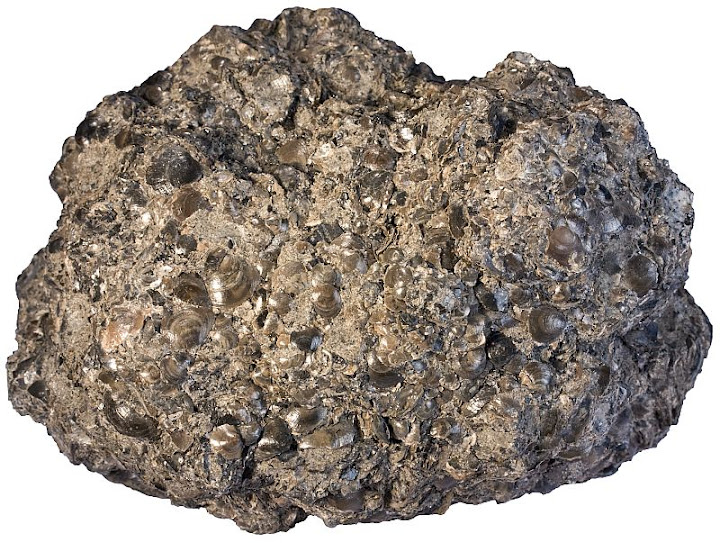
Sandstone with abundant phosphatic shells of brachiopods (Lingulata) from the Ordovician of Estonia. Width of view is 12 cm.
Formation
Sandstone forms when sand layers are buried under sediments. Ground water that moves through the sand layers carries dissolved mineralized matter which precipitates over time to bind individual sand grains into solid rock. The most common binding agents are quartz, calcite, and iron oxides.

This outcrop consists of visibly layered and grainy rocks but it is not sandstone. This is a pyroclastic rock (volcanic sediment) known as tuff. The outcrop is in France (The Massif Central).

This is what happens to sandstone if it gets buried deep enough. Sand grains fuse together to form a metamorphic rock known as quartzite. Telemark, Norway. Width of sample 9 cm.
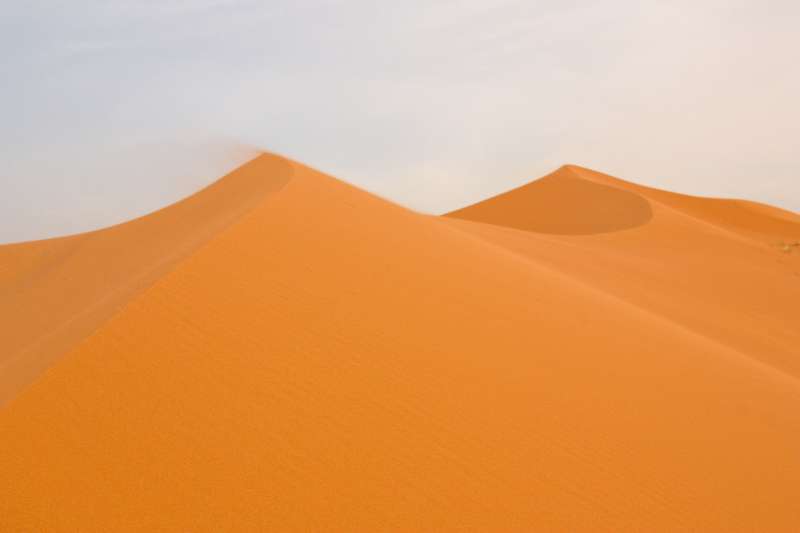
Sand dune in Sahara (Morocco). Sand dunes are in constant motion as you can see here the sand grains blowing off the crest of the dune. But as soon as environmental conditions change enough for the dune to lose its mobility, sand grains will be slowly cemented together by minerals precipitating out from groundwater and the formation of sandstone begins.
Structures
Sandstone structures are easily visible to the naked eye and their study is usually possible only in outcrops. Their scale is simply too large to be studied microscopically. Sedimentary rocks are usually layered and sandstone is no exception. Individual layers are made visible mostly by the variation in grain size. Layers are often easily noticeable because they may be differently colored. This is often also the result of a grain-size variation because water flows more easily in coarser layers and leaves behind more iron oxides. However, layers may also differ in original mineral content right after the deposition.
Common structure is graded bedding which means that the grain-size gets gradually smaller, usually from coarse at the bottom to the finer sand at the top. This indicates that the current that carried sand grains gradually lost its velocity. Cross-stratification or cross-bedding is a structure where parts of the rock sequence are deposited at an angle to the main sequence. Cross-bedding suggests that the sand form as a whole was slowly moving down-current. There are many types of cross-stratification which are not easy to differentiate because outcrops generally show us only a two-dimensional snapshot of the whole sandy dataset.

Unconsolidated dune sand in Estonia. Rust-colored layers are slightly coarser.
Alternating layers of conglomerate, fine-grained, and coarse-grained sandstone from Ireland.

Alternating layers of fine- and coarse-grained sandstone, and conglomerate in a pebble from Estonia.

Tilted muddy sandstone (wacke) layers on the eastern coast of Ireland.
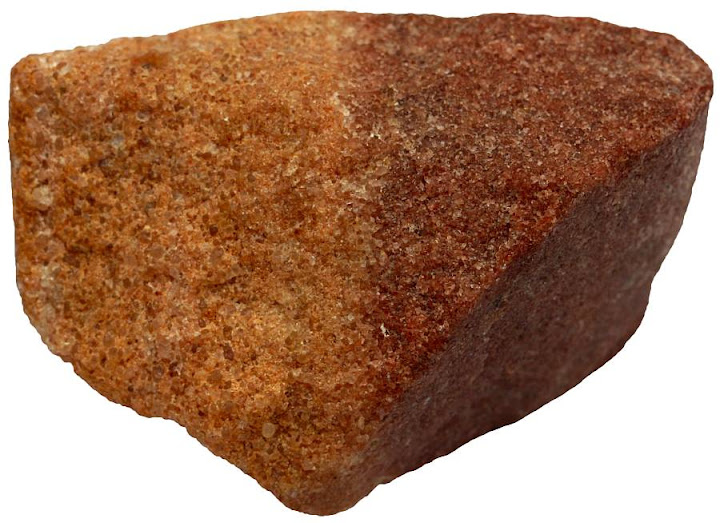
Strongly cemented sandstone from Estonia from the Proterozoic (it formed roughly 1.4 billion years ago). Width of sample 4 cm.

Sandstone is usually known as layered and often cross-stratified sedimentary rock, but sometimes it may form even columns. These columns occur in the Negev Desert (Makhtesh Ramon), Israel.
Color
The color of sandstone is highly variable. The most common mineral in most sandstones is quartz which is colorless if pure. Hence, pure quartzose sandstone tends to be light-colored (picture below about quartz arenite). However, these sand grains are often covered with very fine-grained hematitic pigment which gives variable shade of reddish color to the rock. The cement is usually responsible for the color of sandstone although the main coloring agent may sometimes make up less than 1% of the rocks volume. This is a common situation with redbeds to which vivid red color is given by a small amounts of iron oxide (mostly hematite). Sandstones that contain lots of rock fragments (lithic sandstones) are often dark-colored. Such sandstones are known as graywacke although this term is a bit old-fashioned nowadays.

Coarse-grained strongly cemented sandstone (gritstone) from Israel. Hematite gives it a reddish color which is very typical to sandstones. The width of the sample is 8 cm.

An outcrop of sandstone on the eastern coast of Scotland. Hematite is again responsible for the reddish coloration.
Types
Sandstone is a granular rock, but usually it is assumed that these grains are mostly composed of silicate minerals. Clastic rock which is composed of carbonate shells is considered to be a special type of limestone (calcarenite or coquina), not sandstone or conglomerate.

Poorly sorted lithic rock (graywacke) from Scotland. The width of the sample is 8 cm.
Uses
Sandstone is a rock type which has many uses. Strongly cemented rocks are used as a building material all over the world where the material is readily available. Sandstone is often used in construction.
Crushed sandstone (as sand) is a common filling material in road construction and sand is a principal component of concrete. Pure quartz sand is a source of silica which is used to make glass, carborundum, and semiconductors. Some strong rocks with sharp grains (gritstone) are good for grinding.
Special types of crushed sandstones are used in agriculture as a soil conditioners (lime sand) or fertilizer (glauconite sand). Chemical industry uses sandstone because it is very resistant to most acids (however, this is true if the sand is really almost pure quartz sand). Because the rock is porous, it is by far the most important reservoir rock of ground water and hydrocarbons (crude oil and natural gas).
This rock is also a very valuable material for geologists because it is abundant, resistant to diagenesis, and contains lots of information to reconstruct the Earth’s geologic history.

Glauconite is a green silicate mineral that usually occurs in marine sandstones and gives them greenish color. Glauconite sand may be used as a fertilizer. This sample of greenbed is from Estonia. The width of the sample is 5 cm.
References
1. Jackson, J. A. (1997). Glossary of Geology, 4th Edition. American Geological Institute.
It’s my pleasure to work on these posts and my hope that it would be useful and pleasurable for others as well.
Wow 84,o48 spam comments and only one that is actually meaningful? thats a little sad. anyway thank you so much for this.
it really helped me with my science homework.
I love the picture of sandstone on the east of Scotland. Would it be possible to have a copy for reference for the colours in my textile work please? I will understand if it is not possible
Judy, I am glad that you like it. You are free to use it.
I just bought a rock because I thought it was neat (at an auction) I was wondering if I could e-mail you a picture of it. Maybe you would know what it is. Thanks
Thank you so much for your very nice and rich and accurate informations
Kindly make a category for Mudstone
what does sand stone and shale have in common and what do they have in difference
Sandstone and shale are both terrigenous (from land) clastic sediments (composed of grains or particles). They differ in average grain size. Sand is composed of visible grains. Shale is composed of mud which is a very fine-grained sediment.